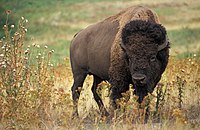
Photo from wikipedia
The paper presents a description of a rare finding of the partial frozen corpse of the Yukagir horse. Discovered from thawing deposits in northern East Siberia (Yakutia, Russia), its age… Click to show full abstract
The paper presents a description of a rare finding of the partial frozen corpse of the Yukagir horse. Discovered from thawing deposits in northern East Siberia (Yakutia, Russia), its age is confirmed to be Mid-Holocene (about 4600 BP). The mummy had a preserved head with the neck and the back of the torso with the legs and tail. The Yukagir horse was relatively short, with short ears and tail. Compared to the modern breeds, including the Yakutian domestic horse, wild Przewalski’s horse, and extinct Lena horse, Equus lenensis, the Yukagir horse was closest to the latter, which was also confirmed by studies of the hair microstructure. The pollen and plant remains from the horse’s intestines indicated a preference to grasses. The late geological age of the Yukagir horse is an indication that this species survived the Pleistocene–Holocene crisis and lived through the Mid-Holocene in northern Eastern Siberia.
Journal Title: Mammal Research
Year Published: 2018
Link to full text (if available)
Share on Social Media: Sign Up to like & get
recommendations!